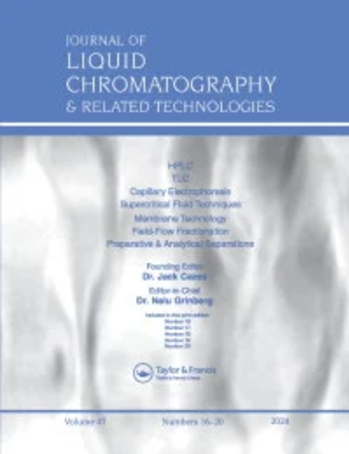富马酸喹硫平中遗传毒性杂质2-(2-氯乙氧基)乙醇的高效液相色谱-质谱联用方法
IF 1.2
4区 化学
Q4 BIOCHEMICAL RESEARCH METHODS
Journal of Liquid Chromatography & Related Technologies
Pub Date : 2023-11-09
DOI:10.1080/10826076.2023.2276283
引用次数: 0
摘要
采用Waters Acquity UHPLC系统与Waters Micromass Quattro PremierXE (MS/MS)联用,建立了一种选择性灵敏的反相方法,对富马酸喹硫平中痕量(~ 2.0 ppm)的遗传毒性杂质2-(2-氯乙氧基)乙醇进行了鉴定和定量。方法采用正离子电喷雾电离,采用多反应监测检测方式,色谱柱为ACE3 C18(100 mm × 4.6 mm × 3.0µm)。采用0.01 M醋酸铵,以20:80v/v的比例溶于milliq水(流动相A)和甲醇(流动相B),建立了等温程序。采用三联四极杆质谱仪,进样量10 μl,柱箱温度40℃,自动进样器温度15℃,流速0.5 mL/min,监测2-(2-氯乙氧基)乙醇的洗脱。2-(2-氯乙氧基)乙醇的停留时间为2.38 min,在浓度为0.235 ppm和0.070 ppm时测定定量限和定量限。相关系数R2为0.9983,加样回收率为98.1% ~ 114.0%。该方法按照国际统一委员会(ICH Q2(R1)和ICH M7(R1))对遗传毒性杂质的要求成功验证。该方法灵敏度高、选择性好、准确度高、精密度好,可用于富马酸喹硫平中遗传毒性杂质2-(2-氯乙氧基)乙醇的鉴定和定量。关键词:2-(2-氯乙氧基)乙醇毒性杂质奎硫平hplc - ms / mms多反应监测(MRM)披露声明作者未报告潜在利益冲突。作者感谢Kshetra Analytics Ltd (Hyderabad, TS, India)和Jawaharlal Nehru Technological University, Anantapur (AP, India)的管理层对开展本研究的支持和鼓励。本文表达了作者自己的观点。作者Shaik mohammad Ali和Manchuri Krishna Moorthy目前在印度海得拉巴的诺华医疗保健私人有限公司工作。本文章由计算机程序翻译,如有差异,请以英文原文为准。
A novel UHPLC-MS/MS method for trace level identification and quantification of genotoxic impurity 2-(2-chloroethoxy) ethanol in quetiapine fumarate
AbstractA selective and sensitive new reversed-phase method was developed and validated by using Waters Acquity UHPLC system coupled with Waters Micromass Quattro PremierXE (MS/MS) to identify and quantify the genotoxic impurity 2-(2-chloroethoxy) ethanol at trace level (∼2.0 ppm) in quetiapine fumarate. The method used positive ion electrospray ionization with a multiple reaction monitoring detection mode using ACE3 C18(100 mm × 4.6 mm × 3.0 µm) column. For analysis, an isocratic program was developed using 0.01 M ammonium acetate in Milli-Q water (mobile phase A) and methanol (mobile phase B) in 20:80v/v ratio. Elution of 2-(2-chloroethoxy) ethanol was monitored using triple quadrupole mass spectrometer with an injection volume of 10 μl, a column oven temperature of 40 °C, an auto-sampler temperature of 15 °C, and flow rate of 0.5 mL/min. The retention time of 2-(2-chloroethoxy) ethanol was observed at 2.38 min. The LOQ and LOD were determined at concentrations of 0.235 ppm and 0.070 ppm respectively. The correlation coefficient R2 was 0.9983 and the percent recoveries of method range from 98.1% to 114.0%. The method was successfully validated according to International Council for Harmonization requirements (ICH Q2(R1) and ICH M7(R1)) for genotoxic impurities. The method was sensitive, selective, accurate and precise and therefore can be used for identification and quantification of genotoxic impurity 2-(2-chloroethoxy) ethanol in quetiapine fumarate.Keywords: 2-(2-chloroethoxy) ethanolgenotoxic impurityquetiapineUHPLC-MS/MSMultiple reaction monitoring (MRM) Disclosure statementNo potential conflict of interest was reported by the author(s).AcknowledgementsThe authors thank the management of Kshetra Analytics Ltd (Hyderabad, TS, India) and Jawaharlal Nehru Technological University, Anantapur (AP, India) for their support and encouragement to conduct this research.The author’s own views were expressed in this paper. The authors Shaik Mahammad Ali and Manchuri Krishna Moorthy are currently working for Novartis Health Care Pvt Ltd, Hyderabad, India.
求助全文
通过发布文献求助,成功后即可免费获取论文全文。
去求助
来源期刊
CiteScore
2.80
自引率
0.00%
发文量
29
审稿时长
4.9 months
期刊介绍:
The Journal of Liquid Chromatography & Related Technologies is an internationally acclaimed forum for fast publication of critical, peer reviewed manuscripts dealing with analytical, preparative and process scale liquid chromatography and all of its related technologies, including TLC, capillary electrophoresis, capillary electrochromatography, supercritical fluid chromatography and extraction, field-flow technologies, affinity, and much more. New separation methodologies are added when they are developed. Papers dealing with research and development results, as well as critical reviews of important technologies, are published in the Journal.

 求助内容:
求助内容: 应助结果提醒方式:
应助结果提醒方式:


